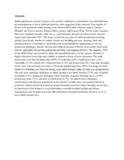| dc.identifier.citation | Serem, J. K., Wanyoike, M. M., Gachuiri, C. K., Mailu, S. K., Gathumbi, P. K., Mwanza, R. N., ... & Borter, D. K. (2013). Characterization of Rabbit Production Systems in Kenya. Journal of Agricultural Science and Applications, 2(3). | en_US |
| dc.description.abstract | Rabbit production systems in Kenya were studied; challenges to production were identified and recommendations to boost rabbit productivity were suggested in this research. Four regions of Kenya with significant rabbit farming were selected: Rift valley (Nakuru county), Central (Kiambu and Nyeri counties), Eastern (Meru county) and Coastal (Taita Taveta county) regions. Data were obtained through a field survey, questionnaires and personal observations between August and September 2011. The study covered the key areas of rabbit production including: general farm details, number of rabbits, breeds and breeding practices, housing, feeds and feeding practices, Constraints to production and recommendations appertaining to the key production challenges. Results showed that rabbit production in Kenya were mainly small scale (84.8%) principally for income generation and home consumption (89.6%). The majority (75%) of the rabbit farms were owned by either the household heads or by the spouses. Farmers of higher education levels kept more rabbits compared to those of lower education. The main breeds kept were New Zealand white (29%), Crossbreeds (24%), Californian white (12%), Chinchilla (11.5%), Dutch (8%), Flemish Giant (5.5%) and French Lop (4%). The main breeding stocks were selected from own stocks or from the neighboring farms (90%). Exchange of males (bucks) for breeding was observed among some rabbit farmers, either for free or at an agreed fee. The four most important challenges to rabbit farming were rabbit diseases (71%), lack of market for rabbits (51%), inadequate husbandry (28%) and lack of quality breeding stock (15.5%), insufficient funds (11%) and lack of rabbit feeds (8.7%). To address these challenges, sensitization of the Kenyan population on the benefits of rabbit meat consumption should be promoted, farmers should be trained on proper husbandry practices, better breeding stocks must be introduced to the farmers to avoid inbreeding, research on rabbit feeding and disease management must be improved to provide information on proper husbandry practices so as to boost rabbit productivity. | en_US |




